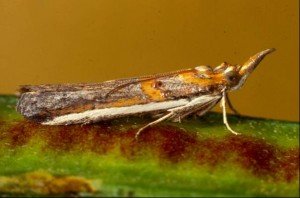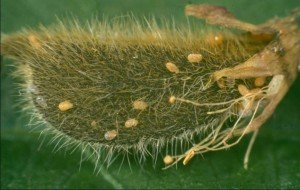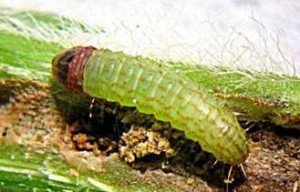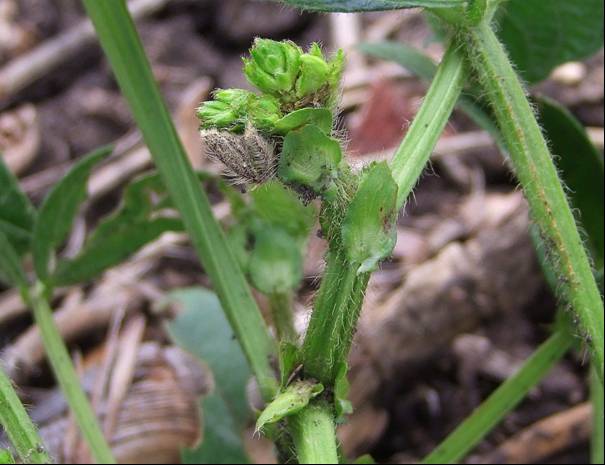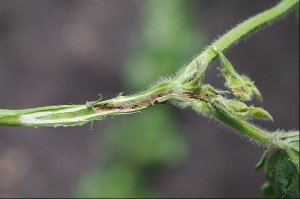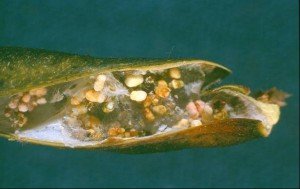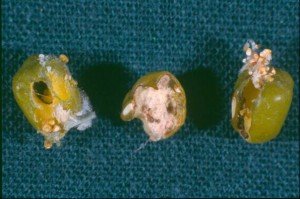A significant etiella outbreak was recently reported in pod-filling mungbean in the Moree region of North Western NSW. In this particular crop, it is estimated that etiella larvae have infested pods on 50% of plants. Etiella eggs, at low densities, were also recently observed in an early flowering crop near Bungunya (west of Goondiwindi, Qld).
Identification
Etiella (Etiella behrii) is also known as the Lucerne seed web moth. Elliptical shaped eggs are laid on pods and flowers or under bracts and are very hard to detect. Newly-hatched larvae bore straight into pods leaving a near-invisible entry hole. The larvae are pale cream/orange when small while larger larvae are cream or green with pink stripes. Larvae nearing pupation often have a pink tinge all over. Etiella can be differentiated from bean podborer which has distinctive black spots.
Damage at budding and flowering
Etiella larvae feed on buds and flowers, damaging these structures. Larger larva may also tunnel into plant stems. Major infestations in crops at the budding/flowering stage will likely reduce yield however there are no validated thresholds for etiella at this crop stage. For this reason, researchers in GRDC’s Northern Grains IPM project would welcome any reports of, and samples from currently infested crops and again at harvest.
Crops with adequate moisture will most likely compensate for low to moderate levels of early damage but major damage would most likely reduce crop yield.
Preliminary data in soybean suggests this crop can compensate for early stem damage by setting additional side branches. However, it is unknown how well, or if mungbean can compensate for this type of damage.
Damage at late pod-fill
Late damage at the pod-fill stage will reduce yield because of the direct consumption of seeds. Data from soybean shows each etiella larvae consumes only 0.2 gram which is equivalent to one soybean seed. Because mungbean seeds are smaller, it is likely that each etiella will consume more seeds, possibly as many as 4 to 5. However, the yield loss in mungbean is likely to be similar to that in soybean, which is 2kg/ha for every larva per square metre. This equates to a theoretical threshold of 30 to 40 larvae/m2. This is a very high threshold but keep in mind that etiella larvae are much smaller than helicoverpa larvae and therefore consume proportionally less. Also remember that this is a theoretical threshold as trials last year suggest that once larvae are inside pods, they are very difficult if not impossible to control.
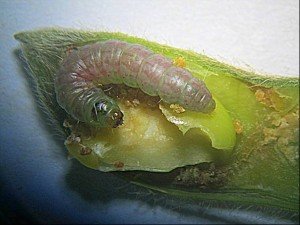
Large etiella larva (13 mm) in soybean pod. Note pinkish colour typical of large larvae approaching pupation
Quality issues
Quality may be an issue if a significant number of seeds only have partial damage, and they are not lost out the back of the header at harvest. The risk of partial seed damage could increase in black pods where, as the seeds dry down, larva feeding could conceivably slow down and larvae fail to reach full size by harvest.
Assessments of damaged samples from infested mungbean crops will enable researchers to measure the impact of etiella damage on mungbean seed quality, and establish threshold guidelines. Researchers are also keen to evaluate insecticides registered in the crop against other pod-boring caterpillars (helicoverpa and bean podborer).
Anyone with suspected etiella damage, please contact Hugh Brier, DAFF Kingaroy on 0428 188 069.

